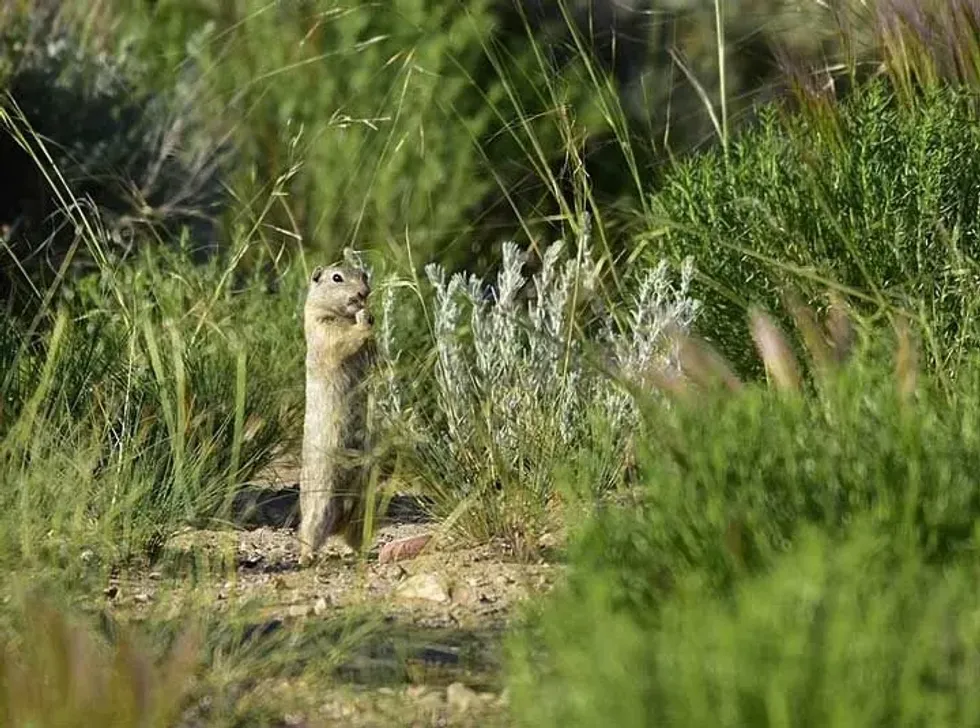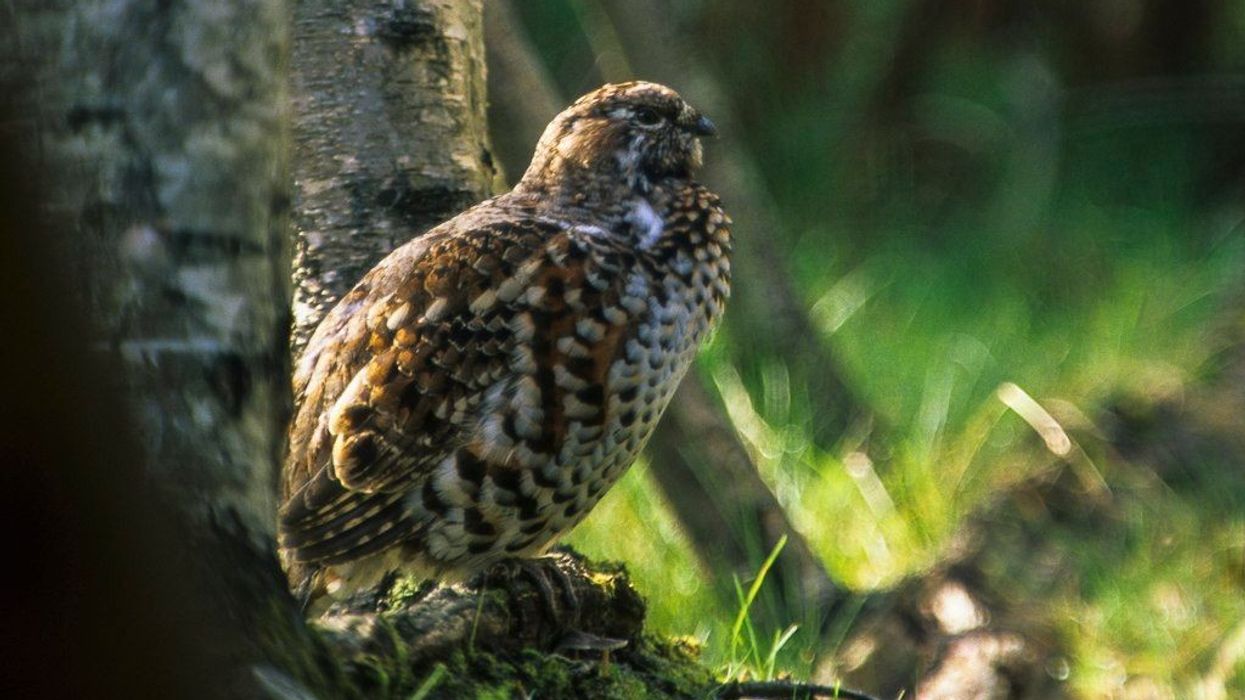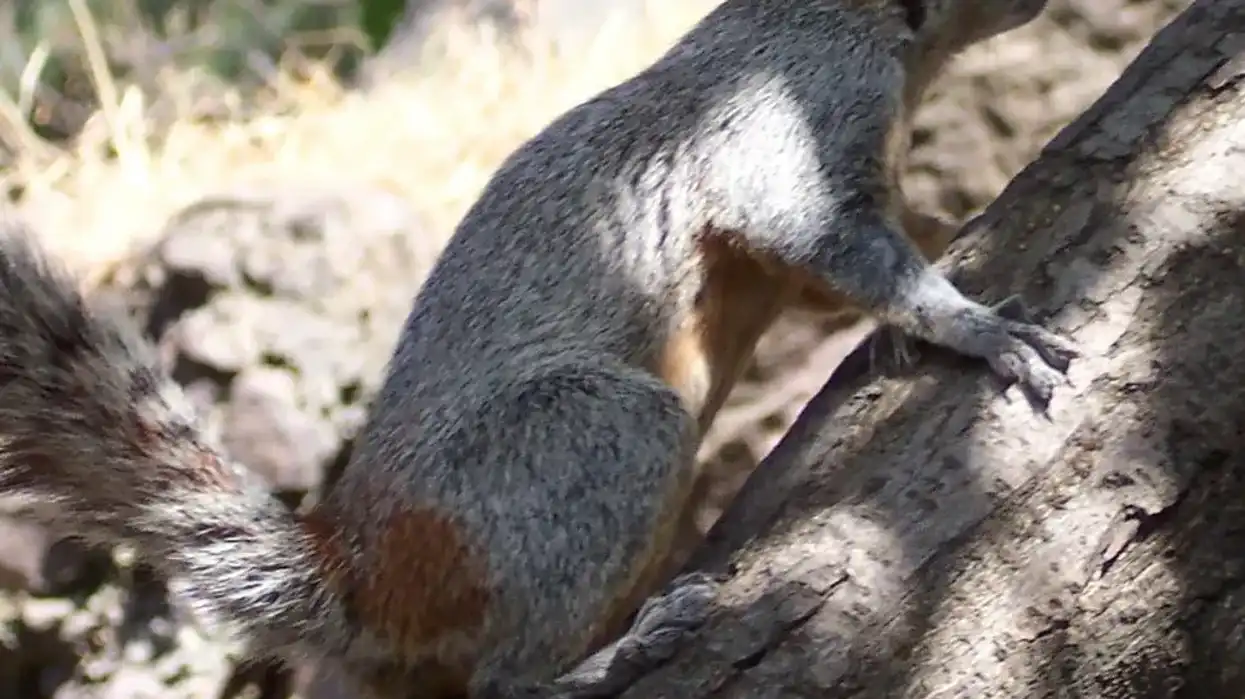The Wyoming ground squirrel is a rodent species that belongs to the order Rodentia and the family Sciuridae. It likes to live in meadows and slopes on high mountains. The Wyoming ground squirrel distribution ranges from Colorado to Nebraska.
The food habits are almost the same in every subspecies of ground squirrels. As a herbivore, it feeds on green foliage such as leaves of plants and grasses.
When there is not enough food it also eats tiny insects. Many predators of this squirrel include dogs, cats, foxes, and hawks. This squirrel's habitat consists of tree holes or underground burrows depending on the location.
The breeding season starts in early spring after hibernation. Females take more time to get up from hibernation than males. They also eat more so that they can gain significant weight for hibernation.
The proportion of females is more than males. This squirrel has a complicated burrow system. There is one main burrow entrance and numerous secondary entrances.
Many burrows are interlinked with each other. The nest is located in the center of the burrow. They are lovely animals, who are restless in nature and forage for food when the weather is pleasant and stores them for bad weathers in their burrows.
Squirrel species and rodents are quite amusing and interesting to learn about. To know more about them, you can also check out lesser Egyptian jerboa and salt marsh harvest mouse.
Wyoming Ground Squirrel Interesting Facts
What type of animal is a Wyoming ground squirrel?
The Wyoming ground squirrel is a species of rodents, endemic to Colorado.
What class of animal does a Wyoming ground squirrel belong to?
This rodent species belong to the class Mammalia of phylum Chordata.
How many Wyoming ground squirrels are there in the world?
The Wyoming ground squirrels (Urocitellus elegans or Spermophilus elegans) are common in the local regions. However, the overall estimate population number of this species is unavailable.
Where does a Wyoming ground squirrel live?
The different subspecies of the Wyoming ground squirrel range have been observed in different areas. Three subtypes are found in different regions.
Spermophilus elegans aureus lives in northeastern Idaho and southwestern Montana, whereas Spermophilus elegans nevadensis thrive in north central Nevada, southeastern Oregon, and southwestern Idaho. The third subspecies is Spermophilus elegans elegans which mainly survive in northeastern Utah, northern Colorado, southern Wyoming, and western Nebraska.
All types of Wyoming squirrels occupy regions from 5,000 ft (1.5 km) to above timberline in the various sections of Colorado. These animals live in a burrow, which keeps them warm and safe from harsh weathers and predators.
What is a Wyoming Ground Squirrel's habitat?
The Wyoming ground squirrel habitat includes talus slopes and mountain meadows. It also lives in sagebrush, and grasslands with shrubs where it is restricted to the lower part of the valley by other species, such as Sympatric spermophilus.
It is quite common in certain areas with boggy soil that is appropriate for digging burrows. It prefers well-drained upland slopes. Wyoming has designated its pet name high mountain prairie dog, due to its high tolerance to elevations, and will prosper if there are no predators.
Who do Wyoming ground squirrels live with?
Like other species of squirrels, the Wyoming ground squirrels like to live alone or in pairs. Wyoming males are usually solitary. However, the squirrels live in family groups in a particular range but do not interact with each other. They are rarely seen in groups but can be seen while eating food at one place.
How long does a Wyoming ground squirrel live?
The Wyoming ground squirrel life ranges are different in its three subspecies. Only one out of four squirrels survive in their primary year of life. The adult's lifespan is between three and four years.
How do they reproduce?
The Wyoming ground squirrels are polygynous animals. Males fight or compete with each other for females.
When females wake up from hibernation, they mate with males. Interestingly, males emerge two weeks before females. After waking up from hibernation, males protect their territories from other males.
After mating, they stop defending their territory. Prior to mating, when a male goes to a female, he sniffs her nose.
He then withdraws some steps and shoves dust toward her. Again, he approaches the female, bites her back and neck. Then both raise their tales.
The male gently rubs her genital area and mounts her from the back, grasping her with his front paws. The breeding happens in the spring season when the squirrels wake up from hibernation.
The time of mating depends on various factors, such as snow conditions, latitude, and the extremity of spring weather. The gestation period is from 22-23 days. After which, from 1-11 offspring are born.
The parturition occurs at the end of April to early May and lasts for about 95 minutes. The babies of Spermophilus elegans appear above the surface of the earth by the end of May or early June.
The mating can be restricted by late emergence from hibernation. The young ones are small when born, nearly 0.2 oz (6 g). They are furless with closed eyes and ears.
The fur develops within two weeks. However, at the age of one month, the weight of young offspring is between 2.8-3.5 oz (80-100 g).
The young babies detach after 28-42 days but do not travel far from the burrow entrance. There is no much information regarding parental care of these ground squirrels because it is arduous to see the caring and nursing in the burrows of squirrels.
Although, it is known that the mothers keep the young babies in the burrows from the very starting of the summer season.
In the late summer, the young disseminate from the mothers. The males move away from their native range but the females stay within their mother's range.
What is their conservation status?
The Wyoming ground squirrels are considered an unguarded nongame species. The conservation status of these squirrels is listed as Least Concern by the IUCN (International Union for Conservation of Nature). These are quite usual in their habitats throughout their range.
Wyoming Ground Squirrel Fun Facts
What do Wyoming ground squirrels look like?
Males and females of the Wyoming squirrels look similar. They have larger ears than a normal ground squirrel.
The eyes have a white border. Like other ground squirrels, they do not possess stripes on the dorsal side.
The upper side is brown with a hue of gray on the neck, head, and shoulders. The stomach is yellowish and the nose is cinnamon-colored.
These ground squirrels also have a short brown tail of about 2.3-3.1 in (59-79 mm), along with strong and large claws to help them dig their burrow. These animals shed the hair mainly in spring or summer and that too once a year. The shedding of fur depends on their sex and reproductive circumstances.
The Spermophilus elegans look similar in appearance to the Richardson's ground squirrels. Therefore, for a long time period, the Wyoming ground squirrels were believed to be Richardson's ground squirrels subspecies.
Although, after genetic testing, and confirming the number of chromosomes, the Wyoming species of squirrels was put into a separate category. This category includes three subspecies that live in different locations in the United States.

How cute are they?
Their tiny body size, cute ears, and long furry tail make them look adorable and cute. It is very interesting to watch them, especially while eating food.
How do they communicate?
The Wyoming squirrels are verbal and constantly call others that are present above ground to aware them of predators. The 'chirp' is the common call of these diminutive animals.
It's a row of short high pitched notes. Another call is 'churr,' but it is a long duration call and can listen over a larger distance than the chirp.
When they are aggressive, they jerk their tails, and when they are excited they raise their tails in an upward position. Like other animal babies, the young offsprings like to play with each other. The species also communicate through scent marks and touch.
For instance, they kiss to greet each other. These small creatures also use the same senses to recognize their territory and environment.
How big is a Wyoming ground squirrel?
The Wyoming ground squirrel size is about 10-15 in (25.4-38.1 cm), which is five times bigger than a black rat.
How fast can a Wyoming ground squirrel run?
Like other squirrels, the Wyoming squirrels can run 20 mph (32 kph). They are also great climbers and jumpers. The ground squirrels are known for their quick movements.
How much does a Wyoming ground squirrel weigh?
Wyoming ground squirrels' weight ranges up to 11.2 oz (320 g).
What are the male and female names of the species?
The male and female do not have specific names.
What would you call a baby Wyoming ground squirrel?
The youngs of the ground squirrels are known as pups.
What do they eat?
The Wyoming ground squirrel food includes green foliage like leaves and grasses but they also eat other plant parts, including roots, nuts, seeds, shrubs, exotic bulbs, berries, flowers, and stems. Seeds of plants are one of their favorite food items.
During scarcity of green foliage, they will eat small insects, such as crickets, moths, grasshoppers, and eggs of some ground-nesting birds. They also eat carrion.
Like all other squirrels, these ground squirrels also found food items that have high water content. Also, the food habits are almost similar in every subspecies of Wyoming ground squirrels.
Are they dangerous?
The species of Wyoming squirrels are not as dangerous as other higher animals or poisonous creatures. However, these ground squirrels can host fleas that are the carriers of the Colorado tick fever virus and bubonic plague.
The ground squirrels are also field pests. They build burrows that can damage the agriculture equipment, such as haying machines, and also take crop fields out of yielding. In addition to all this, burrowing can also vandalize golf courses, gardens, parks, and lawns.
Would they make a good pet?
. There are certain restrictions on keeping them as pets in various parts of the world. So before adopting ground squirrels or any other species make sure about the laws in your city or state.
Did you know...
Various predators of a ground squirrel include cats, badgers, weasels, snakes, hawks, and foxes.
Previously, it was known as Richardson's ground squirrel.
How high can Wyoming ground squirrels jump?
The Wyoming squirrels are excellent jumpers but the exact estimation is unknown.
Wyoming ground squirrel vs prairie dog
There are two main differences between the prairie dog and Wyoming ground squirrel. The first one is that the prairie dog has a black eyebrow, which lacks in the ground squirrel. The second one is that the former squirrel has a white belly, whereas the latter one has a yellowish belly.
Here at Kidadl, we have carefully created lots of interesting family-friendly animal facts for everyone to discover! Learn more about some other mammals from our white-footed mouse facts and gopher facts pages.
You can even occupy yourself at home by coloring one in on our Wyoming Ground Squirrel coloring pages.









